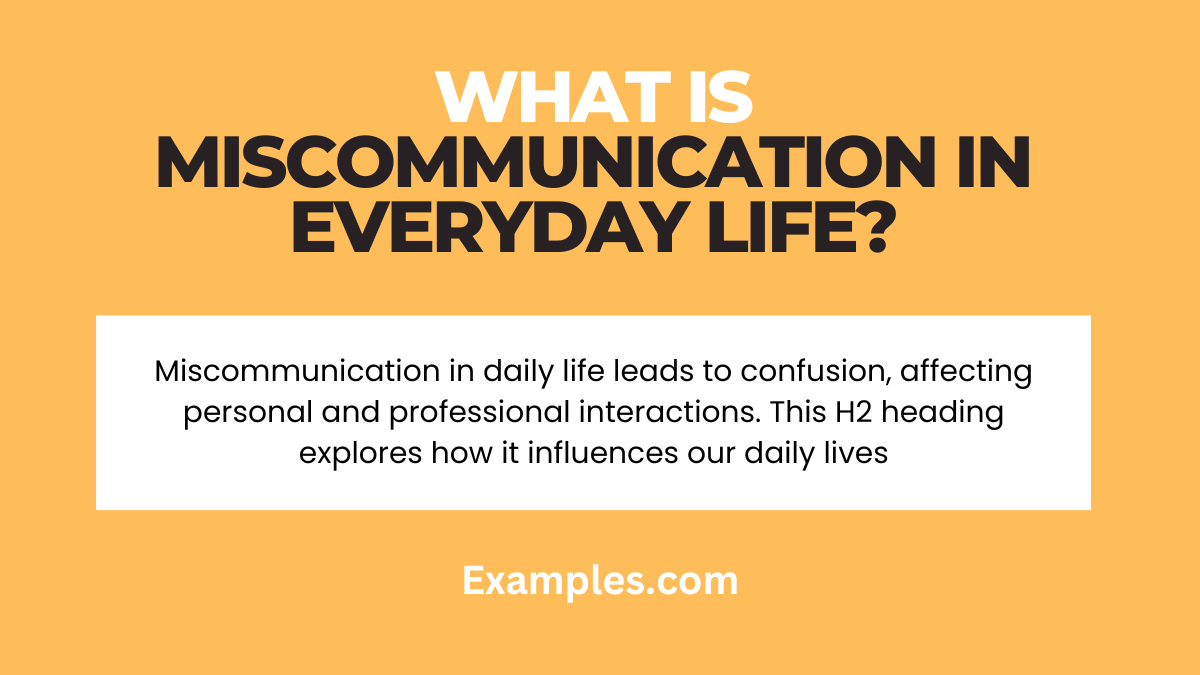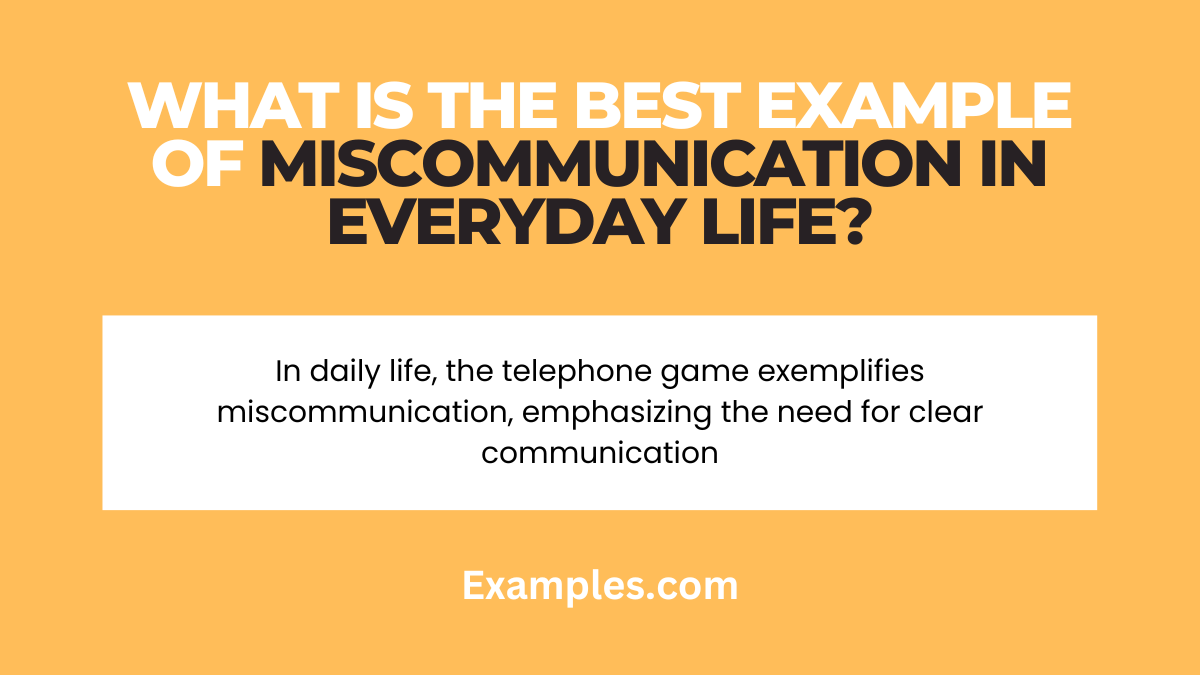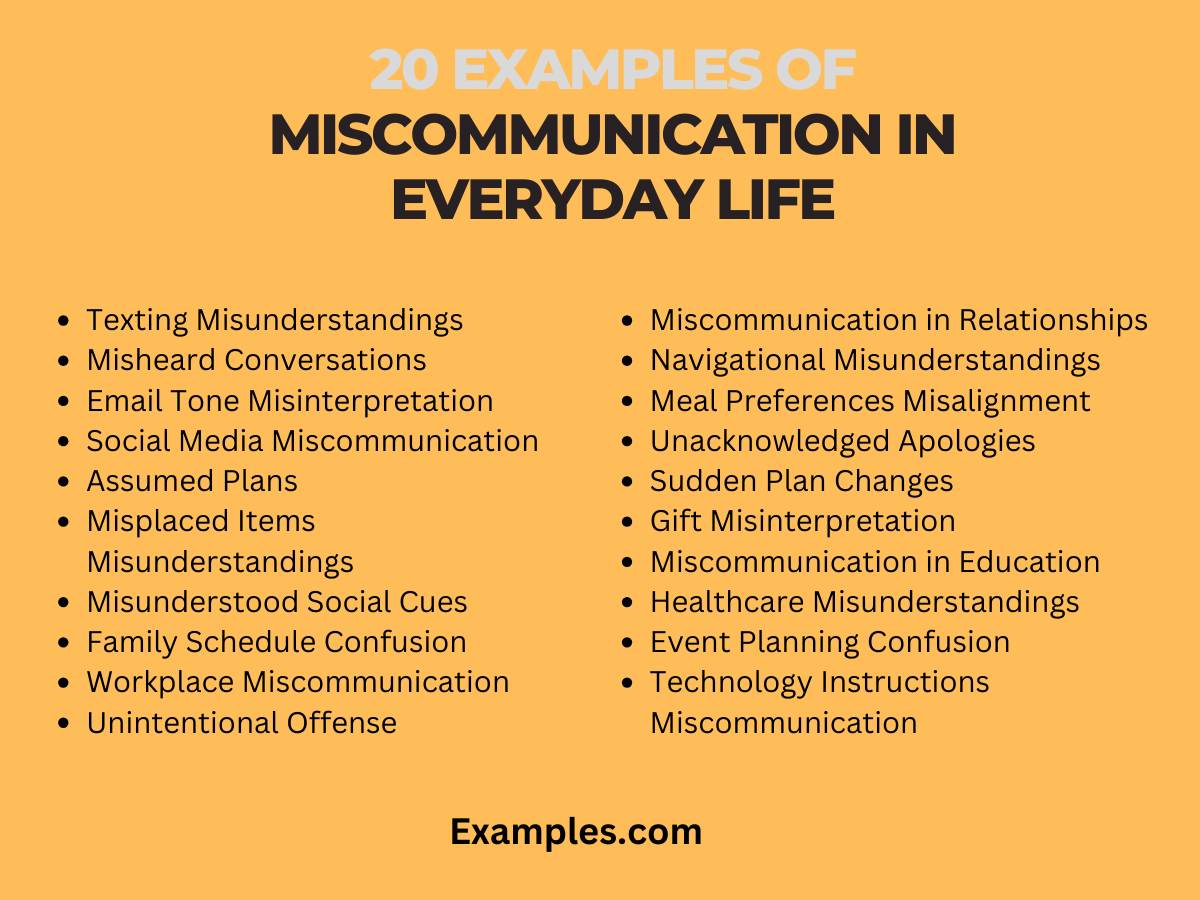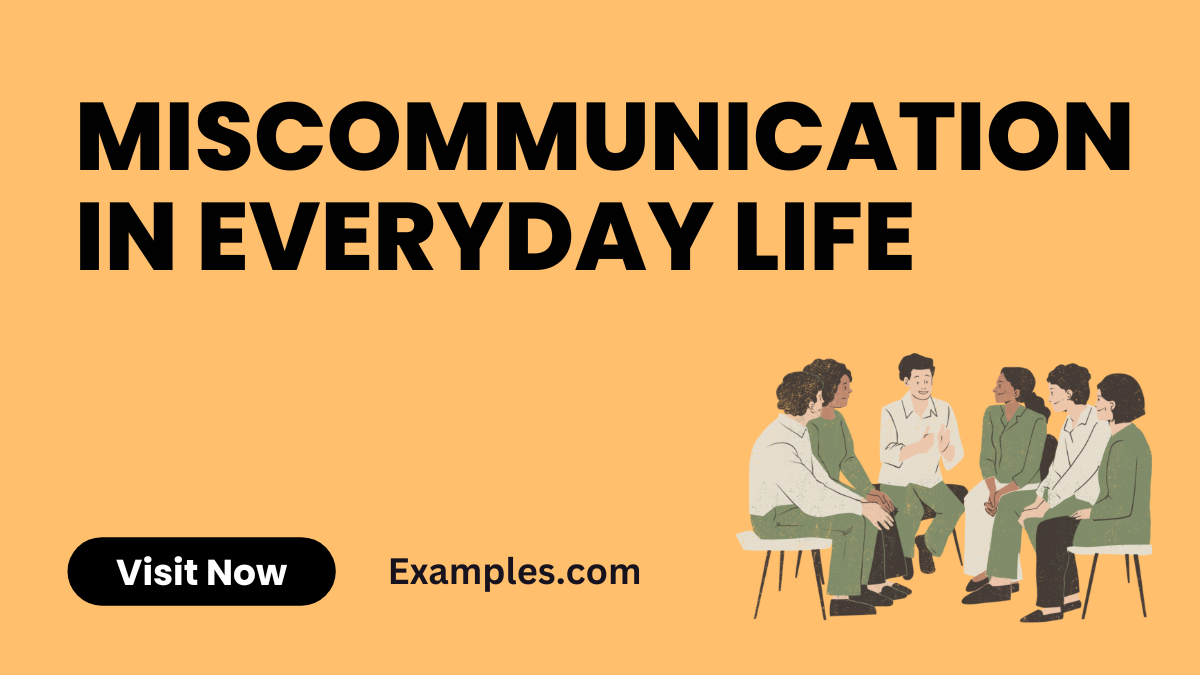20+ Miscommunication in Everyday Life Examples
Embark on a journey to unravel the intricacies of communication in everyday life with our comprehensive guide. Discover practical strategies and insightful examples to navigate through common miscommunication pitfalls. Empower yourself with valuable tips on fostering clear and meaningful connections, ensuring your interactions resonate positively in various aspects of your daily experiences. Dive into the world of Communication Examples to enhance your communication skills and transform the way you engage with the world around you.
What is Miscommunication in Everyday Life?

Miscommunication in Everyday Life refers to instances where information is not effectively exchanged or understood, leading to confusion, misunderstandings, and potential disruptions in daily interactions. It encompasses verbal and non-verbal communication breakdowns, hindering the accurate transmission of messages between individuals in various contexts, from personal relationships to professional settings. This H2 heading delves into the straightforward definition of how miscommunication influences our daily lives.
What is the best Example of Miscommunication in Everyday Life?

In the realm of everyday life, the classic telephone game serves as a vivid example of miscommunication. As a simple childhood activity, it involves passing a message from one person to another in a whisper, gradually revealing how information can undergo subtle alterations. This example illustrates how even in routine scenarios, the transmission of messages can be distorted, emphasizing the importance of clear communication.
20 Examples of Miscommunication in Everyday Life

- Texting Misunderstandings:
- Description: Ambiguous texts often lead to confusion.
- How to Avoid: Be concise, use emojis, seek clarity.
- How to Fix: Confirm meaning, apologize for confusion.
- Misheard Conversations:
- Description: Words lost in conversation lead to errors.
- How to Avoid: Repeat critical points, confirm understanding.
- How to Fix: Clarify, reiterate important details.
- Email Tone Misinterpretation:
- Description: Ambiguous email tones can cause misunderstandings.
- How to Avoid: Use clear language, avoid sarcasm.
- How to Fix: Clarify intentions, apologize if needed.
- Social Media Miscommunication:
- Description: Online interactions may convey unintended messages.
- How to Avoid: Be clear, double-check before posting.
- How to Fix: Address misunderstandings promptly.
- Assumed Plans:
- Description: Assuming plans lead to conflicting expectations.
- How to Avoid: Confirm details, clarify expectations.
- How to Fix: Discuss and align plans with all parties.
- Misplaced Items Misunderstandings:
- Description: Miscommunication about item locations.
- How to Avoid: Clearly communicate item placements.
- How to Fix: Seek clarification, avoid assumptions.
- Misunderstood Social Cues:
- Description: Non-verbal cues misinterpreted in social settings.
- How to Avoid: Be clear, ask for clarification if unsure.
- How to Fix: Address misunderstandings openly.
- Family Schedule Confusion:
- Description: Conflicting schedules cause disruptions.
- How to Avoid: Share calendars, communicate changes.
- How to Fix: Clarify, find a compromise.
- Workplace Miscommunication:
- Description: Misunderstandings impact work efficiency.
- How to Avoid: Foster open communication, seek feedback.
- How to Fix: Address issues promptly, clarify expectations.
- Unintentional Offense:
- Description: Words causing unintended offense.
- How to Avoid: Choose words carefully, be mindful.
- How to Fix: Apologize, explain intentions clearly.
- Miscommunication in Relationships:
- Description: Relationship expectations not communicated.
- How to Avoid: Discuss expectations openly.
- How to Fix: Communicate needs, find common ground.
- Navigational Misunderstandings:
- Description: Directions misinterpreted, leading to confusion.
- How to Avoid: Use clear landmarks, confirm directions.
- How to Fix: Provide additional guidance, apologize for confusion.
- Meal Preferences Misalignment:
- Description: Misunderstanding dietary preferences.
- How to Avoid: Clearly communicate preferences.
- How to Fix: Apologize, find a suitable alternative.
- Unacknowledged Apologies:
- Description: Apologies not acknowledged.
- How to Avoid: Acknowledge apologies promptly.
- How to Fix: Confirm receipt of apology, address concerns.
- Sudden Plan Changes:
- Description: Changes in plans causing confusion.
- How to Avoid: Communicate changes promptly.
- How to Fix: Apologize for inconvenience, explain changes.
- Gift Misinterpretation:
- Description: Gift intentions misunderstood.
- How to Avoid: Clearly communicate the meaning.
- How to Fix: Explain intentions, express gratitude.
- Miscommunication in Education:
- Description: Students misinterpreting assignment instructions.
- How to Avoid: Provide clear instructions, allow questions.
- How to Fix: Clarify, offer additional guidance.
- Healthcare Misunderstandings:
- Description: Misinterpretation of medical instructions.
- How to Avoid: Simplify explanations, confirm understanding.
- How to Fix: Clarify, ensure patient comprehension.
- Event Planning Confusion:
- Description: Miscommunication about event details.
- How to Avoid: Clearly outline event specifics.
- How to Fix: Confirm details, apologize for confusion.
- Technology Instructions Miscommunication:
- Description: Misunderstanding technology usage.
- How to Avoid: Provide clear instructions, encourage questions.
- How to Fix: Explain, offer additional support.
These examples highlight the importance of clear communication, emphasizing proactive measures to avoid and address miscommunications in various life scenarios.
Why is miscommunication most common in daily life?
- Assumed Understanding: Investigate the tendency to presume comprehension without explicit confirmation.
- Lack of Active Listening: Explore the impact of inadequate listening skills on daily interactions.
- Multifaceted Communication Channels: Analyze how diverse platforms contribute to misunderstandings in everyday communication.
- Emotional Filters: Understand the role of emotions in shaping the interpretation of messages.
- Cultural Variations: Explore how cultural differences contribute to frequent miscommunication.
What is a miscommunication between two people?
- Definition of Miscommunication Between Two People:
- Occurs when messages are inaccurately conveyed or interpreted in interpersonal interactions.
- Causes of Miscommunication:
- Varied perspectives, emotional states, assumptions, and language differences contribute to confusion.
- Impact on Relationships:
- Miscommunication can strain relationships, erode trust, and lead to misunderstandings.
- Common Scenarios:
- Differences in interpretation during conversations, misunderstandings of non-verbal cues, or conflicting assumptions.
- Importance of Clarity:
- Emphasizes the need for clear communication to avoid interpersonal conflicts and build strong connections.
- Addressing Language Differences:
- Language barriers can be mitigated through effective communication strategies and understanding cultural nuances.
- Navigating Emotional Context:
- Recognizing emotional states and addressing them during communication to avoid misinterpretations.
- Promoting Active Listening:
- Encouraging active listening helps ensure messages are accurately received and interpreted.
- Emphasizing Non-Verbal Communication:
- Acknowledging the role of non-verbal cues in communication and promoting clarity in expressions.
- Building Relationship Resilience:
- Strategies for overcoming miscommunication, fostering resilience, and maintaining healthy interpersonal bonds.
What is the cause of miscommunication in daily life?
- Assumptions and Presumptions:
- Making assumptions without clarifying information can lead to misunderstandings.
- Lack of Active Listening:
- Poor listening skills contribute to misinterpretations and miscommunication in daily interactions.
- Technological Distractions:
- Overreliance on digital communication may result in messages being overlooked or misunderstood.
- Cultural Differences:
- Diverse backgrounds bring unique communication styles, leading to potential misunderstandings.
- Lack of Feedback Mechanism:
- Absence of constructive feedback channels hinders individuals from understanding their communication shortcomings.
- Information Overload:
- Excessive information can overwhelm, causing crucial details to be overlooked in daily communication.
- Unclear Expectations:
- Lack of explicit communication about expectations can lead to assumptions and confusion.
- Ineffective Leadership Communication:
- Leaders who fail to communicate effectively may create confusion and misunderstanding among teams.
- Fear of Speaking Up:
- A culture where individuals fear voicing concerns impedes open communication in daily interactions.
- Timing Issues:
- Sharing information at the wrong time may lead to confusion; ensuring timely communication is crucial in daily life.
How to avoid miscommunication in daily life?
- Clear Articulation:
- Express thoughts and ideas clearly, minimizing room for interpretation.
- Active Listening:
- Practice attentive listening, seeking clarification when necessary to ensure understanding.
- Use of Visual Aids:
- Employ visual tools like charts or diagrams to enhance clarity, especially in complex discussions.
- Timely Communication:
- Share information at appropriate times to align with the context of the situation.
- Feedback Culture:
- Establish a feedback-friendly environment to address and improve communication shortcomings.
- Cultural Awareness:
- Foster understanding of diverse communication styles and encourage open dialogue about cultural differences.
- Explicit Expectations:
- Clearly articulate expectations to avoid assumptions and create a common understanding.
- Leadership Transparency:
- Leaders should communicate vision, goals, and strategies transparently to guide teams effectively.
- Promote Speaking Up:
- Cultivate an environment where individuals feel comfortable voicing concerns and asking questions.
- Effective Use of Technology:
- Choose communication tools wisely, provide necessary training, and be mindful of digital communication limitations.
In daily life, miscommunication can lead to conflict, stress, and disrupted relationships. This guide explored the causes, effects, and preventive strategies for navigating communication pitfalls. Examples illustrated how misunderstandings can arise and provided insights into fostering clearer, more effective communication. By emphasizing clarity, active listening, and cultural awareness, individuals can minimize miscommunication’s impact, fostering harmonious connections in their everyday interactions.



